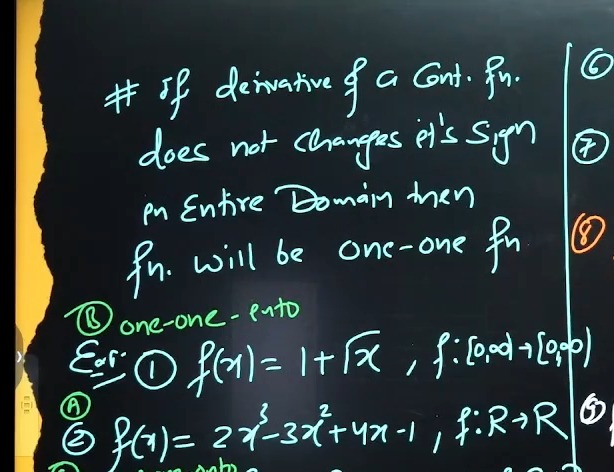Question
Question: If the derivative of a continuous function does not change its sign on its entire domain, then the f...
If the derivative of a continuous function does not change its sign on its entire domain, then the function will be one-one.

The statement is correct. A continuous function whose derivative does not change sign on its domain is strictly monotonic, and therefore one-to-one. For the given examples:
- f(x)=1+x on [0,∞) has f′(x)=2x1>0 for x>0. It is one-to-one but not onto as its range is [1,∞) while codomain is [0,∞).
- f(x)=2x3−3x2+4x−1 on R has f′(x)=6x2−6x+4. The discriminant is (−6)2−4(6)(4)=36−96=−60<0. Since the leading coefficient is positive, f′(x)>0 for all x∈R. It is strictly increasing and thus one-to-one. As a cubic polynomial, its range is R, so it is also onto.
Solution
The core principle is that if a continuous function's derivative maintains a consistent sign (always positive or always negative) across its entire domain, the function is strictly monotonic (either strictly increasing or strictly decreasing). Strictly monotonic functions are inherently one-to-one because each output value corresponds to a unique input value.
Analysis of Example 1: f(x)=1+x on the domain [0,∞).
- Continuity: The function is continuous on [0,∞).
- Derivative: For x>0, f′(x)=2x1.
- Sign of Derivative: For all x∈(0,∞), f′(x)>0. The derivative does not change sign.
- One-to-One: Since f′(x)>0, the function is strictly increasing and thus one-to-one.
- Onto: The range of f(x) for x∈[0,∞) is [1,∞). The given codomain is [0,∞). Since the range is not equal to the codomain, the function is not onto.
- Conclusion for Example 1: One-to-one but not onto.
Analysis of Example 2: f(x)=2x3−3x2+4x−1 on the domain R.
- Continuity: This is a polynomial function, so it is continuous on R.
- Derivative: f′(x)=6x2−6x+4.
- Sign of Derivative: To determine the sign of f′(x), we examine its discriminant. For the quadratic ax2+bx+c, the discriminant is Δ=b2−4ac. Here, a=6, b=−6, c=4. Δ=(−6)2−4(6)(4)=36−96=−60. Since Δ<0 and the leading coefficient (a=6) is positive, the quadratic f′(x) is always positive for all x∈R. The derivative does not change sign.
- One-to-One: Since f′(x)>0, the function is strictly increasing and thus one-to-one.
- Onto: As a cubic polynomial with a positive leading coefficient, limx→∞f(x)=∞ and limx→−∞f(x)=−∞. Therefore, the range of the function is R, which matches the codomain R. The function is onto.
- Conclusion for Example 2: One-to-one and onto.
